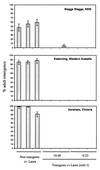Bean alpha-amylase inhibitor 1 in transgenic peas (Pisum sativum) provides complete protection from pea weevil (Bruchus pisorum) under field conditions
- PMID: 10759552
- PMCID: PMC18100
- DOI: 10.1073/pnas.070054597
Bean alpha-amylase inhibitor 1 in transgenic peas (Pisum sativum) provides complete protection from pea weevil (Bruchus pisorum) under field conditions
Abstract
Two alpha-amylase inhibitors, called alphaAI-1 and alphaAI-2, that share 78% amino acid sequence identity and have a differential specificity toward mammalian and insect alpha-amylases are present in different accessions of the common bean (Phaseolus vulgaris). Using greenhouse-grown transgenic peas (Pisum sativum), we have shown previously that expression of alphaAI-1 in pea seeds can provide complete protection against the pea weevil (Bruchus pisorum). Here, we report that alphaAI-1 also protects peas from the weevil under field conditions. The high degree of protection is explained by our finding that alphaAI-1 inhibits pea bruchid alpha-amylase by 80% over a broad pH range (pH 4.5-6.5). alphaAI-2, on the other hand, is a much less effective inhibitor of pea bruchid alpha-amylase, inhibiting the enzyme by only 40%, and only in the pH 4.0-4.5 range. Nevertheless, this inhibitor was still partially effective in protecting field-grown transgenic peas against pea weevils. The primary effect of alphaAI-2 appeared to be a delay in the maturation of the larvae. This contrasts with the effect of alphaAI-1, which results in larval mortality at the first or second instar. These results are discussed in relationship to the use of amylase inhibitors with different specificities to bring about protection of crops from their insect pests or to decrease insect pest populations below the economic injury level.
Figures





Similar articles
-
Bean alpha-amylase inhibitors in transgenic peas inhibit development of pea weevil larvae.J Econ Entomol. 2007 Aug;100(4):1416-22. doi: 10.1603/0022-0493(2007)100[1416:baiitp]2.0.co;2. J Econ Entomol. 2007. PMID: 17849896
-
Response to water deficit and high temperature of transgenic peas (Pisum sativum L.) containing a seed-specific alpha-amylase inhibitor and the subsequent effects on pea weevil (Bruchus pisorum L.) survival.J Exp Bot. 2004 Feb;55(396):497-505. doi: 10.1093/jxb/erh037. Epub 2004 Jan 12. J Exp Bot. 2004. PMID: 14718496
-
Comparison of the α-amylase inhibitor-1 from common bean (Phaseolus vulgaris) varieties and transgenic expression in other legumes--post-translational modifications and immunogenicity.J Agric Food Chem. 2011 Jun 8;59(11):6047-54. doi: 10.1021/jf200456j. Epub 2011 May 13. J Agric Food Chem. 2011. PMID: 21542649
-
Peas (Pisum sativum L.).Methods Mol Biol. 2006;343:337-45. doi: 10.1385/1-59745-130-4:337. Methods Mol Biol. 2006. PMID: 16988357 Review.
-
Plant alpha-amylase inhibitors and their interaction with insect alpha-amylases.Eur J Biochem. 2002 Jan;269(2):397-412. doi: 10.1046/j.0014-2956.2001.02656.x. Eur J Biochem. 2002. PMID: 11856298 Review.
Cited by
-
Agrobacterium-mediated transformation of chickpea with alpha-amylase inhibitor gene for insect resistance.J Biosci. 2006 Sep;31(3):339-45. doi: 10.1007/BF02704106. J Biosci. 2006. PMID: 17006016
-
Characterization of digestive enzymes of bruchid parasitoids-initial steps for environmental risk assessment of genetically modified legumes.PLoS One. 2012;7(5):e36862. doi: 10.1371/journal.pone.0036862. Epub 2012 May 16. PLoS One. 2012. PMID: 22615826 Free PMC article.
-
Plant defense against insect herbivores.Int J Mol Sci. 2013 May 16;14(5):10242-97. doi: 10.3390/ijms140510242. Int J Mol Sci. 2013. PMID: 23681010 Free PMC article. Review.
-
Cloning and functional expression of the gene encoding an inhibitor against Aspergillus flavus alpha-amylase, a novel seed lectin from Lablab purpureus (Dolichos lablab).Plant Cell Rep. 2007 Apr;26(4):395-405. doi: 10.1007/s00299-006-0250-2. Epub 2006 Dec 6. Plant Cell Rep. 2007. PMID: 17149640
-
Molecular cloning and expression of an alpha-amylase inhibitor from rye with potential for controlling insect pests.Protein J. 2005 Feb;24(2):113-23. doi: 10.1007/s10930-004-1518-4. Protein J. 2005. PMID: 16003953
References
-
- Roush R T, Shelton A M. Nat Biotech. 1997;15:816–817. - PubMed
-
- Reek G R, Kramer K J, Baker J E, Kanost M R, Fabrick J A, Behnke C A. In: Advances in Insect Control: The Role of Transgenic Plants. Carozzi N, Koziel M, editors. London: Taylor & Francis; 1997. pp. 157–183.
-
- Chrispeels M J. In: Advances in Insect Control. The Role of Transgenic Plants. Carozzi N, Koziel M, editors. London: Taylor & Francis; 1997. pp. 139–156.
-
- Ho M F, Whitaker J R. J Food Biochem. 1993;17:15–33.
-
- Ho M F, Whitaker J R. J Food Biochem. 1993;17:35–52.
Publication types
MeSH terms
Substances
LinkOut - more resources
Full Text Sources

